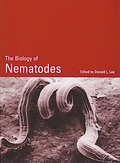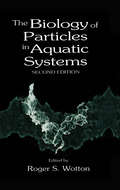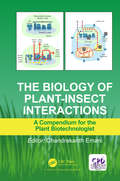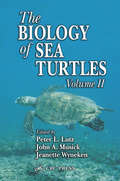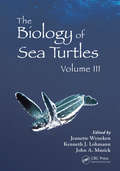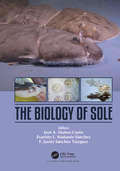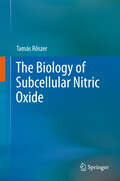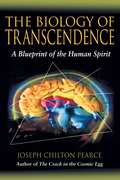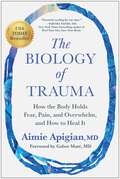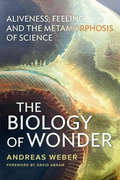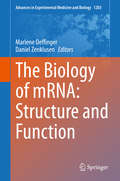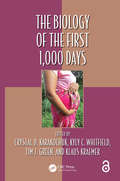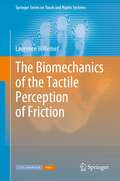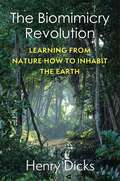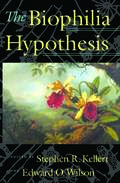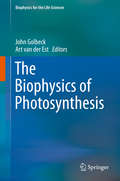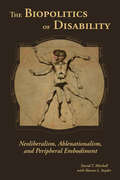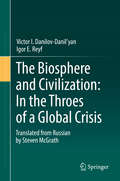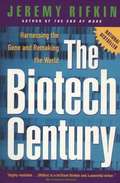- Table View
- List View
The Biology of Nematodes
by Donald L. LeeThe Biology of Nematodes synthesizes knowledge of the biology of free-living, plant-parasitic, and animal-parasitic nematodes. Contributed works by recognized researchers apply groundbreaking molecular techniques, many of which resulted from work on Caenorhabditis elegans, toward new approaches to the study of nematode worms. Topics covered
The Biology of Oligodendrocytes
by Patricia J. Armati Emily K. MatheyTraditionally, oligodendrocytes have been assumed to play a minor supporting role in the central nervous system and their importance has generally been overlooked. For the first time, this book provides a dedicated review of all of the major aspects of oligodendrocyte biology, including development, organization, genetics, and immunobiology. Later chapters emphasize the importance of this underestimated cell to the mammalian central nervous system by exploring the role of myelin synthesis and maintenance in neural disease and repair. Particular attention is paid to multiple sclerosis (MS), arguably the prime example of an acquired demyelinating disease, with detailed examinations of the current concepts regarding demyelination, oligodendroglial damage, and remyelination in MS lesions.
The Biology of Particles in Aquatic Systems, Second Edition
by Roger S. WottonThe Biology of Particles in Aquatic Systems, Second Edition presents the latest information on particulate and dissolved matter found in aquatic habitats ranging from small streams to oceans. Only by studying this matter can we gain an understanding of the functioning of aquatic ecosystems and thus be able to predict changes that may occur as these systems become stressed. Updated and extensively revised, this new edition covers such topics as classification of particulate and dissolved matter, origin and formation of particles aquatic systems, factors affecting particle aggregation, methods for capturing particles by benthic and planktonic animals, and the use of particulate and dissolved organic matter as food.
The Biology of Plant-Insect Interactions: A Compendium for the Plant Biotechnologist
by Chandrakanth EmaniOverviews of biochemical, genetic, and molecular perspectives of plant-insect interactions with added emphasis on bioinformatic, genomic, and transcriptome analysis are comprehensively treated in this book. It presents the agro-ecological and evolutionary aspects of plant-insect interactions with an exclusive focus on the climate change effect on the resetting of plant-insect interactions. A valuable resource for biotechnologists, entomologists, agricultural scientists, and policymakers, the book includes theoretical aspects as a base toward real-world applications of holistic integrated pest management in agro-ecosystems.
The Biology of Reproduction
by Alessandro Minelli Giuseppe FuscoReproduction is a fundamental feature of life, it is the way life persists across the ages. This book offers new, wider vistas on this fundamental biological phenomenon, exploring how it works through the whole tree of life. It explores facets such as asexual reproduction, parthenogenesis, sex determination and reproductive investment, with a taxonomic coverage extended over all the main groups - animals, plants including 'algae', fungi, protists and bacteria. It collates into one volume perspectives from varied disciplines - including zoology, botany, microbiology, genetics, cell biology, developmental biology, evolutionary biology, animal and plant physiology, and ethology - integrating information into a common language. Crucially, the book aims to identify the commonalties among reproductive phenomena, while demonstrating the diversity even amongst closely related taxa. Its integrated approach makes this a valuable reference book for students and researchers, as well as an effective entry point for deeper study on specific topics.
The Biology of Sea Turtles, Volume I (CRC Marine Science #12)
by Peter L. Lutz John A. MusickSea turtles have existed for millions of years, making them fascinating subjects of study. In the last 20 years, the science of sea turtle biology has expanded at an exponential rate, leading to major advances in many areas. This book synthesizes the results of these advances and focuses on how these endangered marine reptiles operate in, adapt to, and are dependent upon particular features of their marine environment. New technology in data gathering, such as DNA analyses, remote sensing, and physiological monitoring techniques, has led to a much greater understanding of the biology of the sea turtle at all stages of their life history.
The Biology of Sea Turtles, Volume II (ISSN #12)
by Peter L. Lutz John A. Musick Jeanette WynekenThe success of the first volume of The Biology of Sea Turtles revealed a need for broad but comprehensive reviews of major recent advances in sea turtle biology. Biology of Sea Turtles, Volume II emphasizes practical aspects of biology that relate to sea turtle management and to changes in marine and coastal ecosystems. These topics i
The Biology of Sea Turtles, Volume III (CRC Marine Biology Series)
by John A. Musick Jeanette Wyneken Kenneth J. LohmannSince the first volume of The Biology of Sea Turtles was published in 1997, the field has grown and matured in ways few of the authors would have predicted-particularly in the areas of physiology, behavior, genetics, and health. Volume III presents timely coverage of emerging areas as well as the integration of approaches and information that did n
The Biology of Sole
by José A. Munoz-Cueto Evaristo Mañanós-Sánchez F. Javier Sánchez-VázquezThis book reviews up-to-date knowledge on the biology of sole (Solea senegalensis and S. solea). These flatfish species are increasingly important in Europe both from the ecological and production point of view. This book is divided into two sections: A. general fisheries, aquaculture and engineering overviews; B. physiological, developmental, rhythmic, welfare and genetic aspects which will be of immense interest for the aquaculture industry. Experts, from both academia and research institutes, provide their expertise on sole biology.
The Biology of Subcellular Nitric Oxide
by Tamás RőszerThis book fills in a gap in the NO literature. Recent progress in the field of NO-biology shows that NO is generated within distinct cell compartments, including specific plasma membrane regions, mitochondria, chloroplasts, peroxisomes, the Golgi-complex and intracellular membrane systems. NO synthesis plays specific roles in these compartments and, in turn, cell organelles also control intracellular NO levels. This monograph focuses on the roles played by the subcellular NO-signaling microdomains in the prokaryote-, fungus-, plant- and animal cells and shows how NO behaves as an intracellular signal in distinct cellular environments. This monograph also provides a summary of our knowledge on how NO synthesis came through evolution to be associated with organelles and subcellular compartments. Promotes the novel ideas that some functions of NO and its associations with subcellular units have been conserved during the evolution of the cell. A special chapter is dedicated to the biomedical relevance of subcellular NO synthesis, and this chapter also discusses the evidence that altered compartmentalization of NO-producing enzymes causes disease.
The Biology of Transcendence: A Blueprint of the Human Spirit
by Joseph Chilton PearceUses new research about the brain to explore how we can transcend our current physical and cultural limitations • Reveals that transcendence of current modes of existence requires the dynamic interaction of our fourth and fifth brains (intellect and intelligence) • Explores the idea that Jesus, Lao-tzu, and other great beings in history are models of nature’s possibility and our ability to achieve transcendence • 17,000 sold in hardcover since April 2002 Why do we seem stuck in a culture of violence and injustice? How is it that we can recognize the transcendent ideal represented by figures such as Jesus, Lao-tzu, and many others who have walked among us and yet not seem to reach the same state? In The Biology of Transcendence Joseph Chilton Pearce examines the current biological understanding of our neural organization to address how we can go beyond the limitations and constraints of our current capacities of body and mind--how we can transcend. Recent research in the neurosciences and neurocardiology identifies the four neural centers of our brain and indicates that a fifth such center is located in the heart. This research reveals that the evolutionary structure of our brain and its dynamic interactions with our heart are designed by nature to reach beyond our current evolutionary capacities. We are quite literally, made to transcend. Pearce explores how this “biological imperative” drives our life into ever-greater realms of being--even as the “cultural imperative” of social conformity and behavior counters this genetic heritage, blocks our transcendent capacities, and breeds violence in all its forms. The conflict between religion and spirit is an important part of this struggle. But each of us may overthrow these cultural imperatives to reach “unconflicted behavior,” wherein heart and mind-brain resonate in synchronicity, opening us to levels of possibility beyond the ordinary.
The Biology of Trauma: How the Body Holds Fear, Pain, and Overwhelm, and How to Heal It
by Aimie ApigianThis groundbreaking book breaks down the latest research to reveal how trauma impacts our bodies on a cellular level and offers an empowering path to whole-body healing.Today, we know more about mental health than ever before, but traditional medicine still mistakes subtle signs of trauma for stress, anxiety, or chronic disease—sometimes even retraumatizing patients with outdated and misguided methods. Treatment plans that focus on the mind are only addressing the downstream effects. Likewise, common medical approaches to manage symptoms fail to explore root causes and promote genuine recovery. If we want to truly heal, we need to understand trauma as something happening inside of the body—not as a singular external event. Gaining clarity on how our bodies hold onto experiences, impacting both our physical health and our ability to maintain healthy behaviors and relationships, is crucial. That&’s where Dr. Aimie Apigian&’s integrative, revolutionary approach comes in. With a decade of clinical research, approachable storytelling, and real-life examples, The Biology of Trauma will show you: How the body absorbs scarring experiences and overwhelm Ways to identify commonly overlooked trauma symptoms like lethargy, fogginess, and unexplained worry Recognize how emotional pain stored in the body affects overall health on a cellular level, even for people with functionally successful lives Prevent trauma-induced changes in your biology that suppress the cycle of recovery Work with your nervous system to safely heal—without risk of retraumatization Perfect for both individuals seeking personal growth and health professionals improving their practice, The Biology of Trauma will help you gain deep insights into your own mind, body, and healing journey.
The Biology of Violence: How Understanding the Brain, Behavior, and Environment Can Break the Vicious Circle of Aggression
by Debra NiehoffDebra Niehoff's book is one of the first to examine violence from a complete biological perspective. She ascertains that by understanding human biology, we can control violence in our society. She brings together a wide range of research to support her premise.
The Biology of Wonder: Aliveness, Feeling and the Metamorphosis of Science
by Andreas WeberA new way of understanding our place in the web of life from a scholar praised for his “graceful prose” (Publishers Weekly).The disconnection between humans and nature is perhaps one of the most fundamental problems faced by our species today. This schism is arguably the root cause of most of the environmental catastrophes unraveling around us. Until we come to terms with the depths of our alienation, we will continue to fail to understand that what happens to nature also happens to us.In The Biology of Wonder Andreas Weber proposes a new approach to the biological sciences that puts the human back in nature. He argues that feelings and emotions, far from being superfluous to the study of organisms, are the very foundation of life. From this basic premise flows the development of a "poetic ecology" which intimately connects our species to everything that surrounds us—showing that subjectivity and imagination are prerequisites of biological existence.Written by a leader in the emerging fields of biopoetics and biosemiotics, The Biology of Wonder demonstrates that there is no separation between us and the world we inhabit, and in so doing it validates the essence of our deep experience. By reconciling science with meaning, expression, and emotion, this landmark work brings us to a crucial understanding of our place in the rich and diverse framework of life—a revolution for biology as groundbreaking as the theory of relativity for physics.“Grounded in science, yet eloquently narrated, this is a groundbreaking book. Weber’s visionary work provides new insight into human/nature interconnectedness and the dire consequences we face by remaining disconnected.” —Richard Louv, author of Last Child in the Woods
The Biology of mRNA: Structure and Function (Advances in Experimental Medicine and Biology #1203)
by Marlene Oeffinger Daniel ZenklusenThe book provides an overview on the different aspects of gene regulation from an mRNA centric viewpoint, including how mRNA is assembled and self-assembles in a complex consisting of RNA and proteins, and how its ability to be translated at the right time and space depends on many processes acting on the mRNAs, leading to a properly folded complex. This book shows how new technologies have led to a better understanding of these processes and their connected diseases.The book is written for scientists in fundamental and applied biomedical research working on different aspects of gene regulation. It is also targeted to an audience that is not implicated in these fields directly, but wants to gain a better understanding of mRNA biology.
The Biology of the First 1,000 Days (Oxidative Stress and Disease)
by Tim Green Klaus Kraemer Crystal Karakochuk Kyly WhitfieldThe first 1,000 days, from conception to two years of age, is a critical period of growth and development. Exposures to dietary, environmental, hormonal, and other stressors during this window have been associated with an increased risk of poor health outcomes, some of which are irreversible. The book addresses this crucial interval of early life across biological disciplines, linking concepts related to all biological fields to outcomes during the first 1,000 days (e.g. fetal growth and pregnancy outcomes) and beyond (e.g. gut microbiome and cardiovascular disease later in life). The strength of this book lies in its cross-disciplinary nature.
The Biomarker Guide
by J. M. Moldowan K. E. Peters C. C. WaltersBiomarkers are compounds found in crude oil with structures inherited from once-living organisms. They persist in oil spills, refinery products and archaeological artifacts, and can be used to identify the origin, geological age and environmental conditions prevalent during their formation and alteration. These two volumes will be an invaluable resource for geologists, petroleum geochemists, biogeochemists, environmental and forensic scientists, natural product chemists and archaeologists. The first of two volumes of The Biomarker Guide discusses the origins of biomarkers and introduces basic chemical principles relevant to their study. It goes on to discuss analytical techniques, and the applications of biomarkers in environmental and archaeological problems.
The Biomarker Guide: Biomarkers and Isotopes in the Environment and Human History
by J. M. Moldowan K. E. Peters C. C. WaltersBiomarkers are compounds found in crude oil with structures inherited from once-living organisms. They persist in oil spills, refinery products and archaeological artifacts, and can be used to identify the origin, geological age and environmental conditions prevalent during their formation and alteration. These two volumes will be an invaluable resource for geologists, petroleum geochemists, biogeochemists, environmental and forensic scientists, natural product chemists and archaeologists. The first of two volumes of The Biomarker Guide discusses the origins of biomarkers and introduces basic chemical principles relevant to their study. It goes on to discuss analytical techniques, and the applications of biomarkers in environmental and archaeological problems.
The Biomechanics of the Tactile Perception of Friction (Springer Series on Touch and Haptic Systems)
by Laurence WillemetHumans rely on their sense of touch to perceive subtle movements and micro slippages to manipulate an impressive range of objects. This incredible dexterity relies on fast and unconscious adjustments of the grip force that holds an object strong enough to avoid a catastrophic fall yet gentle enough not to damage it. The Biomechanics of the Tactile Perception of Friction covers how the complex mechanical interaction is perceived by the nervous system to quickly infer the state of the contact for a swift and precise regulation of the grip. The first part focuses on how humans assess friction at the contact initialization and the second part highlights an efficient coding strategy that the nervous system might use to continuously adjust the grip force to keep a constant safety margin before slippage. Taken together, these results reveal how the perception of frictional information is encoded in the deformation of our skin. The findings are useful for designing bio-inspired tactile sensors for robotics or prosthetics and for improving haptic human-machine interactions.
The Biomimicry Revolution: Learning from Nature How to Inhabit the Earth
by Henry DicksModernity is founded on the belief that the world we build is a human invention, not a part of nature. The ecological consequences of this idea have been catastrophic. We have laid waste to natural ecosystems, replacing them with fundamentally unsustainable human designs. With time running out to address the environmental crises we have caused, our best path forward is to turn to nature for guidance.In this book, Henry Dicks explores the philosophical significance of a revolutionary approach to sustainable innovation: biomimicry. The term describes the application and adaptation of strategies found in nature to the development of artificial products and systems, such as passive cooling techniques modeled on termite mounds or solar cells modeled on leaves. Dicks argues that biomimicry, typically seen as just a design strategy, can also serve as the basis for a new environmental philosophy that radically alters how we understand and relate to the natural world. By showing how we can imitate, emulate, and learn from nature, biomimicry points us toward a genuinely sustainable way of inhabiting the earth.Rooted in philosophy, The Biomimicry Revolution has profound implications spanning the natural sciences, design, architecture, sustainability studies, science and technology studies, and the environmental humanities. It presents a sweeping reconception of what philosophy can be and offers a powerful new vision of terrestrial existence.
The Biophilia Hypothesis: The Quest To Make Conservation Profitable
by Edward O. Wilson Stephen R. Kellert Gregory Wilkins Aaron Katcher Cecilia Mccarthy Scott Mcvay"Biophilia" is the term coined by Edward O. Wilson to describe what he believes is humanity's innate affinity for the natural world. In his landmark book Biophilia, he examined how our tendency to focus on life and lifelike processes might be a biologically based need, integral to our development as individuals and as a species. That idea has caught the imagination of diverse thinkers.The Biophilia Hypothesis brings together the views of some of the most creative scientists of our time, each attempting to amplify and refine the concept of biophilia. The variety of perspectives -- psychological, biological, cultural, symbolic, and aesthetic -- frame the theoretical issues by presenting empirical evidence that supports or refutes the hypothesis. Numerous examples illustrate the idea that biophilia and its converse, biophobia, have a genetic component: fear, and even full-blown phobias of snakes and spiders are quick to develop with very little negative reinforcement, while more threatening modern artifacts -- knives, guns, automobiles -- rarely elicit such a response people find trees that are climbable and have a broad, umbrella-like canopy more attractive than trees without these characteristics people would rather look at water, green vegetation, or flowers than built structures of glass and concrete The biophilia hypothesis, if substantiated, provides a powerful argument for the conservation of biological diversity. More important, it implies serious consequences for our well-being as society becomes further estranged from the natural world. Relentless environmental destruction could have a significant impact on our quality of life, not just materially but psychologically and even spiritually.
The Biophysics of Photosynthesis
by John Golbeck Art EstThe volume is intended as an introduction to the physical principles governing the main processes that occur in photosynthesis, with emphasis on the light reactions and electron transport chain. A unique feature of the photosynthetic apparatus is the fact that the molecular structures are known in detail for essentially all of its major components. The availability of this data has allowed their functions to be probed at a very fundamental level to discover the design principles that have guided evolution. Other volumes on photosynthesis have tended to focus on single components or on a specific set of biophysical techniques, and the authors' goal is to provide new researchers with an introduction to the overall field of photosynthesis. The book is divided into sections, each dealing with one of the main physical processes in photosynthetic energy conversion. Each section has several chapters each describing the role that a basic physical property, such as charge or spin, plays in governing the process being discussed. The chapters proceed in an orderly fashion from a quantum mechanical description of early processes on an ultrafast timescale to a classical treatment of electron transfer and catalysis on a biochemical timescale culminating in evolutionary principles on a geological timescale.
The Biopolitics Of Disability: Neoliberalism, Ablenationalism, And Peripheral Embodiment
by David T. MitchellIn the neoliberal era, when human worth is measured by its relative utility within global consumer culture, selected disabled people have been able to gain entrance into late capitalist culture. The Biopolitics of Disability terms this phenomenon "ablenationalism" and asserts that "inclusion" becomes meaningful only if disability is recognized as providing modes of living that are alternatives to governing norms of productivity and independence. Thus, the book pushes beyond questions of impairment to explore how disability subjectivities create new forms of embodied knowledge and collective consciousness. The focus is on the emergence of new crip/queer subjectivities at work in disability arts, disability studies pedagogy, independent and mainstream disability cinema (e. g. , Midnight Cowboy), internet-based medical user groups, anti-normative novels of embodiment (e. g. , Richard Powers's The Echo-Maker) and, finally, the labor of living in "non-productive" bodies within late capitalism.
The Biosphere and Civilization: In the Throes of a Global Crisis
by Victor I. Danilov-Danil'yan Igor E. ReyfThis monograph explores the dire ecological, social, and economic situations facing mankind through comprehensive analyses of global ecological issues, poverty, environmental stability and regulation, and sustainable development. Drs. Victor Danilov-Danil’yan and Igor Reyf discuss the development of ecology as a science, the increasing concern among scientists and public servants for the unsustainability of current economic and demographic trends, and the dire consequences our planet and civilization are already suffering as a result of the ongoing environmental and social crisis. They also address the philosophical implications of the crisis, and suggest possible solutions. The book conveys complex objects of study, namely the biosphere and the harmful anthropogenic processes it has been experiencing for decades, so that the work is accessible without omitting key components of the subject matter. Readers will learn about the social and economic contributors to a threatened biosphere, the mechanisms that maintain the stability of the global environment, and the scales at which sustainable development and preservation can be applied to initiate environmental regulation. Though intended to appeal to the general public and non-specialists, environmental researchers, organizations involved in sustainable development and conservation, and students engaged in ecology, environment, and sustainability studies will also find this book of interest.
The Biotech Century: Harnessing the Gene and Remaking the World
by Jeremy RifkinIn this seminal book, Jeremy Rifkin explores the epic marriage between computer technology and genetic engineering, and the historic transition into the Age of Biotechnology. Already, Rifkin explains, our economy is undergoing a massive shift away from the Industrial Age and into an era in which giant life-science corporations are fashioning a bioindustrial world. Humanity is on the brink of wielding greater control over the shape of life--how we are born; how our food supply is created; the traits our children may have--than has ever been imagined. But with each step into this new era, we must ask ourselves: At what cost?
